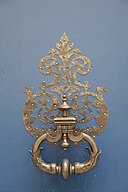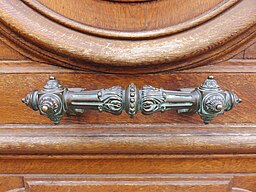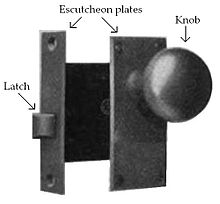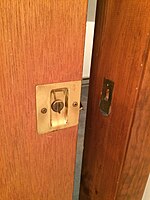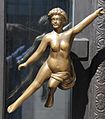
In firearms terminology, an action is the functional mechanism of a breech-loading firearm that handles the ammunition cartridges, or the method by which that mechanism works. Actions are technically not present on muzzleloaders, as all those are single-shot firearms with a closed off breech with the powder and projectile manually loaded from the muzzle. Instead, the muzzleloader ignition mechanism is referred to as the lock.
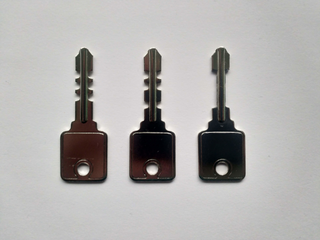
A warded lock is a type of lock that uses a set of obstructions, or wards, to prevent the lock from opening unless the correct key is inserted. The correct key has notches or slots corresponding to the obstructions in the lock, allowing it to rotate freely inside the lock.
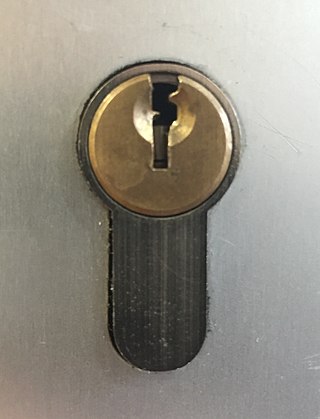
The pin tumbler lock, also known as the Yale lock after the inventor of the modern version, is a lock mechanism that uses pins of varying lengths to prevent the lock from opening without the correct key.

A combination lock is a type of locking device in which a sequence of symbols, usually numbers, is used to open the lock. The sequence may be entered using a single rotating dial which interacts with several discs or cams, by using a set of several rotating discs with inscribed symbols which directly interact with the locking mechanism, or through an electronic or mechanical keypad. Types range from inexpensive three-digit luggage locks to high-security safes. Unlike ordinary padlocks, combination locks do not use keys.

A lock is a mechanical or electronic fastening device that is released by a physical object, by supplying secret information, by a combination thereof, or it may only be able to be opened from one side, such as a door chain.
A child safety lock is a special-purpose lock for cabinets, drawers, bottles, etc. that is designed to help prevent children from getting at any dangerous things or contents. Young children are naturally curious about their surroundings and will always explore, but as they may be unaware of dangerous substances or situations, the results can be fatal. Numerous cases of poisoning have resulted from eating brightly colored pills or spilling cleaning solvents.
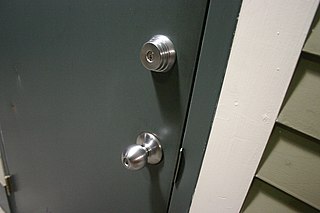
A deadbolt or deadlock is a type of lock morticed into a wooden door. Then, using a key from either side of the door, a bolt is thrown into the door frame, thus securing the door. It is distinct from a spring bolt lock because a deadbolt can only be opened by a key or handle. The more common spring bolt lock uses a spring to hold the bolt in place, allowing retraction by applying force to the bolt itself. A deadbolt can therefore make a door more resistant to entry without the correct key, as well as make the door more resistant to forced entry. A deadbolt is often used to complement a spring-bolt lock on an entry door to a building.

A lever tumbler lock is a type of lock that uses a set of levers to prevent the bolt from moving in the lock. In the simplest form of these, lifting the tumbler above a certain height will allow the bolt to slide past.
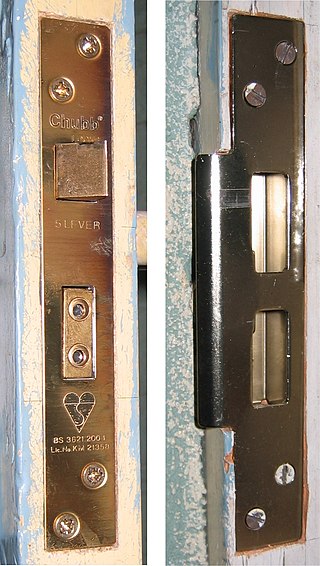
A mortise lock is a lock that requires a pocket—the mortise—to be cut into the edge of the door or piece of furniture into which the lock is to be fitted. In most parts of the world, mortise locks are found on older buildings constructed before the advent of bored cylindrical locks, but they have recently become more common in commercial and upmarket residential construction in the United States. The design is widely used in domestic properties of all vintages in Europe.

A crash bar is a type of door opening mechanism which allows users to open a door by pushing a bar. While originally conceived as a way to prevent crowd crushing in an emergency, crash bars are now used as the primary door opening mechanism in many commercial buildings.
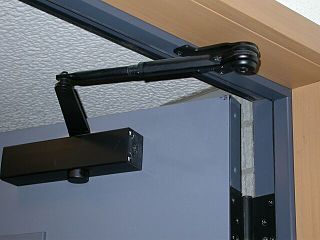
Door furniture or door hardware refers to any of the items that are attached to a door or a drawer to enhance its functionality or appearance.

A breechblock is the part of the firearm action that closes the breech of a breech loading weapon before or at the moment of firing. It seals the breech and contains the pressure generated by the ignited propellant. Retracting the breechblock allows the chamber to be loaded with a cartridge.

A latch or catch is a type of mechanical fastener that joins two objects or surfaces while allowing for their regular separation. A latch typically engages another piece of hardware on the other mounting surface. Depending upon the type and design of the latch, this engaged bit of hardware may be known as a keeper or strike.

An electronic lock is a locking device which operates by means of electric current. Electric locks are sometimes stand-alone with an electronic control assembly mounted directly to the lock. Electric locks may be connected to an access control system, the advantages of which include: key control, where keys can be added and removed without re-keying the lock cylinder; fine access control, where time and place are factors; and transaction logging, where activity is recorded. Electronic locks can also be remotely monitored and controlled, both to lock and to unlock.

An electric strike is an access control device used for door frames. It replaces the fixed strike faceplate often used with a latch. Like a fixed strike plate, it normally presents a ramped or beveled surface to the locking latch allowing the door to close and latch just like a fixed strike would. However, an electric strike's ramped surface can, upon command, pivot out of the way when the lock on the door is in the locked position and the door is opened, allowing a user to pull/push the door to open it without operating the mechanical lock or using a mechanical key. After the door is opened past the keeper, the keeper returns to its standard position and re-locks when power is removed or applied, depending upon the strike's configuration.

Break action is a type of firearm action in which the barrel(s) are hinged much like a door and rotate perpendicularly to the bore axis to expose the breech and allow loading and unloading of cartridges. A separate operation may be required for the cocking of a hammer to fire the new round. There are many types of break-action firearms; break actions are universal in double-barreled shotguns, double-barreled rifles, combination guns, and are commonly found in single shot pistols, rifles, shotguns, including flare guns, grenade launchers, air guns, and some older revolver designs. They are also known as hinge-action, break-open, break-barrel, break-top, or, on old revolvers, top-break actions.

A car door is a type of door opening, typically hinged on its front edge, but sometimes attached by other mechanisms such as tracks, for entering and exiting a vehicle. Doors most often integrate side windows for visibility from inside the car and can be locked to secure the vehicle.

The term door security or door security gate may refer to any of a range of measures used to strengthen doors against door breaching, ram-raiding and lock picking, and prevent crimes such as burglary and home invasions. Door security is used in commercial and government buildings, as well as in residential settings.

A lockset is the hardware and components that make up the locking or latching mechanism that can usually be found on a door or other hinged object but can also include sliding doors and dividers. The components of a lockset can include the door handles, latch bolt, dead bolt, face plate, strike plate, escutcheon, thumbturn, push button, turn button, and other trim. The lockset and associated hardware typically defines a door's function and how a user could access the two adjacent spaces defined by the opening associated with the lockset.
An officer’s tool is a forcible entry device used by firefighters and other first responders. Officer’s tools are designed to completely remove cylindrical locks from doors without causing major structural damage, allowing for direct access to the internal locking mechanism.
